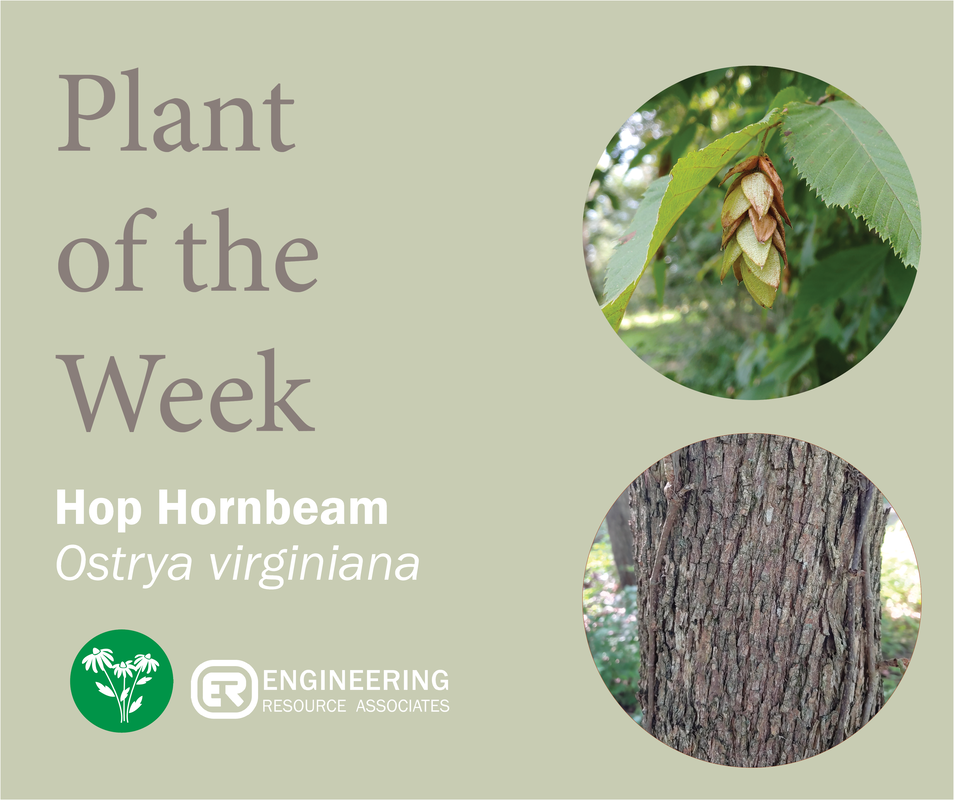This week’s plant of the week is the Hop Hornbeam (Ostrya virginiana). Hop Hornbeam is an uncommon understory tree found throughout Illinois, where it grows primarily in dry to mesic woodlands and woodland clearings.
This interesting tree is easily identifiable by its fruits that resemble the fruits of the Hop Plant, commonly used in flavoring beer. The small delicate fruits are made up of inflated structures that each carry one seed and are a food source for many types of animals including birds, insects, and small mammals. This tree is related to another native Illinois tree, the Musclewood Tree (Carpinus caroliniana).
The importance of the Hop Hornbeam as an individual plant providing food or acting as a host plant serves a great function within the forest but, this tree is also part of the canopy understory. It is a significant piece of forest ecology along with plants such as Eastern Redbud (Cercis canadensis), Musclewood (Carpinus caroliniana), Buttonbush (Cephalanthus occidentalis), and varieties of Dogwood (Cornus sp.) or Viburnums (Viburnum sp.). In Illinois, forests come in many compositions, from the light and airy Oak-Hickory savannas to the dense and shady Maple-Beech forests that cast heavy shade on the ground. All forests contain some lesser level of growth between the tallest trees and the herbaceous layer on the ground, which can vary widely depending on the density of the canopy layer. The forest understory serves multiple functions that contribute to the succession of savanna into forest, allowing more sensitive plants to germinate that may be less tolerant of exposure.
Illinois forests are currently experiencing a rapid loss of understory growth because of invasive species, primarily Honeysuckle and Buckthorn. These two shrubby invaders can shade the forest floor so densely that it can prevent the germination of native species that local wildlife relies on for food and other needs. Without proper management of native areas, we would lose species such as the Hop Hornbeam.
This interesting tree is easily identifiable by its fruits that resemble the fruits of the Hop Plant, commonly used in flavoring beer. The small delicate fruits are made up of inflated structures that each carry one seed and are a food source for many types of animals including birds, insects, and small mammals. This tree is related to another native Illinois tree, the Musclewood Tree (Carpinus caroliniana).
The importance of the Hop Hornbeam as an individual plant providing food or acting as a host plant serves a great function within the forest but, this tree is also part of the canopy understory. It is a significant piece of forest ecology along with plants such as Eastern Redbud (Cercis canadensis), Musclewood (Carpinus caroliniana), Buttonbush (Cephalanthus occidentalis), and varieties of Dogwood (Cornus sp.) or Viburnums (Viburnum sp.). In Illinois, forests come in many compositions, from the light and airy Oak-Hickory savannas to the dense and shady Maple-Beech forests that cast heavy shade on the ground. All forests contain some lesser level of growth between the tallest trees and the herbaceous layer on the ground, which can vary widely depending on the density of the canopy layer. The forest understory serves multiple functions that contribute to the succession of savanna into forest, allowing more sensitive plants to germinate that may be less tolerant of exposure.
Illinois forests are currently experiencing a rapid loss of understory growth because of invasive species, primarily Honeysuckle and Buckthorn. These two shrubby invaders can shade the forest floor so densely that it can prevent the germination of native species that local wildlife relies on for food and other needs. Without proper management of native areas, we would lose species such as the Hop Hornbeam.

